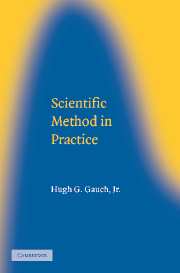Book contents
4 - SCIENCE'S PRESUPPOSITIONS
Published online by Cambridge University Press: 05 March 2015
Summary
Every conclusion of science requires presuppositions, just as necessarily as every conclusion of science requires evidence. Indeed, without appropriate presuppositions, evidence loses its evidential role, and that undoes science. Consequently, any reflective version of science must understand, disclose, and legitimate science's presuppositions.
The concept of “presupposition” will be defined more carefully later. Essentially, a presupposition is a belief that is required to reach a particular conclusion, and yet it cannot possibly be proved. A presupposition cannot be proved in the ordinary sense of marshaling definitive evidence because presuppositions precede and empower evidence. But that does not necessarily mean that presuppositions are arbitrary and shaky. Rather, presuppositions should be chosen carefully, disclosed, and then legitimated by appeal to common sense and sincerity.
Although presuppositions and evidence are equally essential, in ordinary scientific discourse the presuppositions are ignored, whereas the evidence is cited. Why? Basically that is because within the context of ordinary, common-sensical science, the presuppositions needed in science are sensible and unproblematic and are taken for granted. Nevertheless, “Our presuppositions are always with us, never more so than when we think we are doing without them” (O'Hear 1989:54).
Presuppositions and evidence are different in terms of implementation. Legitimating science's presuppositions can be done once and for all, whereas marshaling evidence must be done for each individual scientific inquiry. Envision reading several scientific papers about diabetes, cosmic rays, semiconductors, and turbulence over airplane wings.
- Type
- Chapter
- Information
- Scientific Method in Practice , pp. 112 - 155Publisher: Cambridge University PressPrint publication year: 2002



